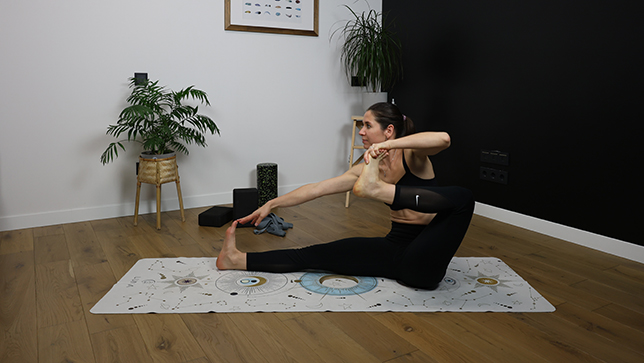Archer Pose - Akarna Dhanurasana

Contents
Archer Pose also known as Akarna Dhanurasana (AH-kar-nah dhon-oor-AH-sah-nah) is an intermediate-level yoga posea that helps to improve focus, balance, and flexibility. This pose is a combination of stretching, balancing, and twisting movements that engage various muscles in the body, particularly the legs, hips, and back.
The word Akarna Dhanurasana is derived from the Sanskrit language where “Karna” means “Ear”, “Dhanura” means “Bow”, and “Asana” is “Pose”. The term “Karna” has “A” as a prefix which means “Near” or “Towards.
In English, the pose is known as Archer pose since the pose resembles the action of an archer drawing an arrow from the bow. To attain this posture, you have to draw one of your feet closer to the ear while the other leg stays extended on the ground. You can also call it Shooting Bow Pose, or Bow-And-Arrow Pose.
Pose Detail
- By Type: Balancing Yoga Poses, Flexibility Yoga Poses, Hip Opening Yoga Poses, Shoulder Opening Yoga Poses, Strengthening Yoga Poses
- Difficulty: Intermediate
- Body Position: Seated Yoga Poses
- By Benefit: Yoga Poses For Digestion, Yoga Poses For Neck Pain
Step-by-Step Instructions
Benefits and Contraindications
Encourages proper elimination
Improves flexibility in the legs
Tones core muscles
Stretches the spine
Relieves back pain
Improves your concentration and focus
Shoulder or hamstring injury
Lower back problems
Herniated disk
Pregnancy
Menstruation
Modifications and Props for Beginners
- If you’re new to the pose, start by holding onto your ankle instead of your toe. As you become more comfortable with the pose, work your way up to holding onto your toe.
- If you have tight hips or limited flexibility, you can use a folded blanket or bolster underneath your hips to elevate them slightly. This can help to reduce the strain on your hips and lower back, making the pose more comfortable.
- If you can’t reach your toes with your opposite hand, you can use a strap or towel to extend your reach. Loop the strap around your foot and hold onto the ends with your opposite hand. You can also hold onto the strap with both hands to deepen the stretch.
- If you have difficulty balancing in the pose, you can use a wall or chair for support.
Useful Tips
- To begin with, always make sure that you go through a proper warm-up session to avoid any muscle strain.
- Like any other exercise, you must synchronise your breath and movements while doing this yoga.
- Start with the preparatory poses if you find the archer’s pose difficult.
- You can also practice easier versions of the same exercise prior to trying the advanced asana.
Frequently Asked Questions
While Archer Pose is an intermediate yoga pose, beginners can practice the pose with modifications or with the support of props. It is important to work within your limits and avoid forcing the body beyond its capacity.
Archer Pose is generally safe for most people, but it may not be suitable for those with certain injuries or health conditions, such as knee or hip injuries, back pain, or digestive issues.
You can progress in Archer Pose or Akarna Dhanurasana by gradually increasing the duration of the pose and by working on the full expression of the pose, which involves holding onto your big toe with your hand. You can also try different variations of the pose, such as twisting deeper or adding a bind. As with any yoga pose, progress should be slow and steady, and always listen to your body’s signals.
Some common mistakes to avoid in Archer Pose include rounding the spine, collapsing forward, and forcing the torso to twist beyond its capacity. It is important to maintain proper alignment and to listen to your body’s signals.
Variations
- Standing Archer Pose
- Bound Leg Archer Pose
- Revolved Archer Pose